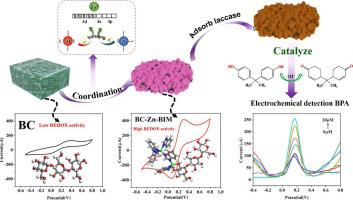当前位置:
X-MOL 学术
›
Carbohydr. Polym.
›
论文详情
Our official English website, www.x-mol.net, welcomes your feedback! (Note: you will need to create a separate account there.)
Charge transport properties and mechanisms of bacterial cellulose (BC)-Zinc complexes
Carbohydrate Polymers ( IF 11.2 ) Pub Date : 2024-03-16 , DOI: 10.1016/j.carbpol.2024.122066 Rui Zhao , Tianshuo Zhang , Xianglin Qiu , Ziyi Cao , Shanshan Gao , Xiaoming Song , Yue Li , Fushan Chen , Xinyi Zhou
Carbohydrate Polymers ( IF 11.2 ) Pub Date : 2024-03-16 , DOI: 10.1016/j.carbpol.2024.122066 Rui Zhao , Tianshuo Zhang , Xianglin Qiu , Ziyi Cao , Shanshan Gao , Xiaoming Song , Yue Li , Fushan Chen , Xinyi Zhou

|
Most current flexible electronic devices are based on petroleum materials that are difficult to degrade. The exploration of sustainable and eco-friendly materials has become a major focus in both the scientific and industrial communities. In this study, BC-Zn-BIM (bacterial cellulose-Zn-benzimidazole), a novel composite electrode material based on biodegradable BC was developed. Here, BC acted as a conductive medium involved in the conductive behavior of the composite material. We've explored the charge transport mechanisms of BC-Zn-BIM by density functional theory (DFT) calculations, and applied it in the electrochemical detection of Bisphenol A (BPA). The results indicated that the oxygen-containing groups in BC and the nitrogen-containing heterocycles in BIM have a tendency to lose electrons, whereas zinc ions actively acquire electrons from these groups. This process promoted charge transfer within BC-Zn-BIM and endowed it with semiconductor-like properties, enhancing the electrocatalytic reaction of BPA. The detection limit of the electrochemical biosensor was 12 nM, and the sample recovery was 95.1%105.6%. This study clarified the mechanism of the higher electrical properties achieved in Zn-BIM complex grown in-situ on dielectric BC. This will further promote the development of low-cost, environmentally friendly flexible electronic devices.
中文翻译:

细菌纤维素(BC)-锌配合物的电荷传输特性和机制
目前大多数柔性电子设备都是基于难以降解的石油材料。探索可持续和环保材料已成为科学界和工业界的主要焦点。本研究开发了一种基于可生物降解BC的新型复合电极材料BC-Zn-BIM(细菌纤维素-Zn-苯并咪唑)。在这里,BC充当导电介质,参与复合材料的导电行为。我们通过密度泛函理论(DFT)计算探索了BC-Zn-BIM的电荷传输机制,并将其应用于双酚A(BPA)的电化学检测。结果表明,BC中的含氧基团和BIM中的含氮杂环有失去电子的倾向,而锌离子则积极地从这些基团中获取电子。该过程促进了 BC-Zn-BIM 内的电荷转移,并赋予其类似半导体的特性,从而增强了 BPA 的电催化反应。电化学生物传感器的检测限为12 nM,样品回收率为95.1%105.6%。这项研究阐明了在电介质 BC 上原位生长的 Zn-BIM 复合物实现更高电性能的机制。这将进一步推动低成本、环保型柔性电子器件的发展。
更新日期:2024-03-16
中文翻译:

细菌纤维素(BC)-锌配合物的电荷传输特性和机制
目前大多数柔性电子设备都是基于难以降解的石油材料。探索可持续和环保材料已成为科学界和工业界的主要焦点。本研究开发了一种基于可生物降解BC的新型复合电极材料BC-Zn-BIM(细菌纤维素-Zn-苯并咪唑)。在这里,BC充当导电介质,参与复合材料的导电行为。我们通过密度泛函理论(DFT)计算探索了BC-Zn-BIM的电荷传输机制,并将其应用于双酚A(BPA)的电化学检测。结果表明,BC中的含氧基团和BIM中的含氮杂环有失去电子的倾向,而锌离子则积极地从这些基团中获取电子。该过程促进了 BC-Zn-BIM 内的电荷转移,并赋予其类似半导体的特性,从而增强了 BPA 的电催化反应。电化学生物传感器的检测限为12 nM,样品回收率为95.1%105.6%。这项研究阐明了在电介质 BC 上原位生长的 Zn-BIM 复合物实现更高电性能的机制。这将进一步推动低成本、环保型柔性电子器件的发展。



























 京公网安备 11010802027423号
京公网安备 11010802027423号